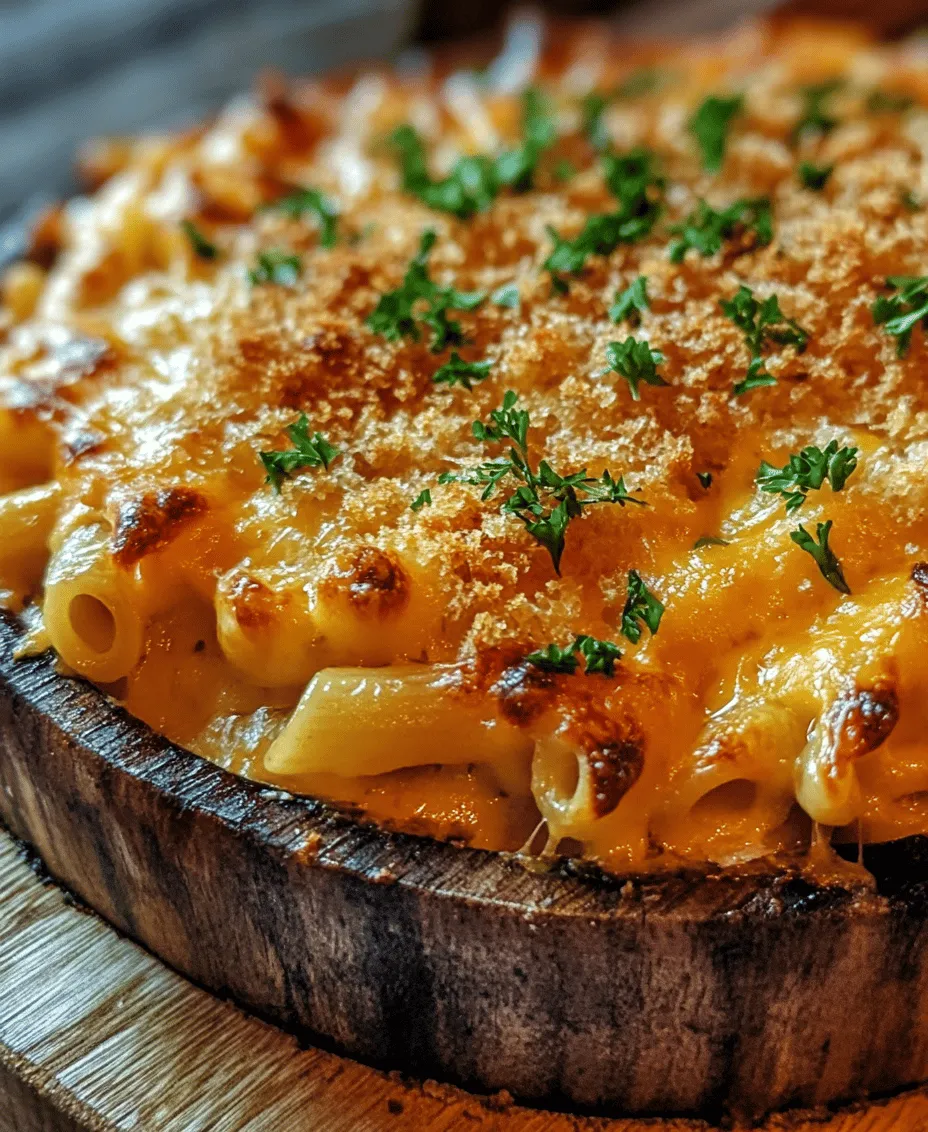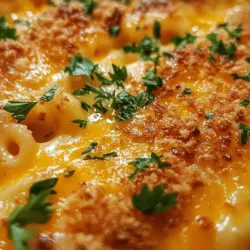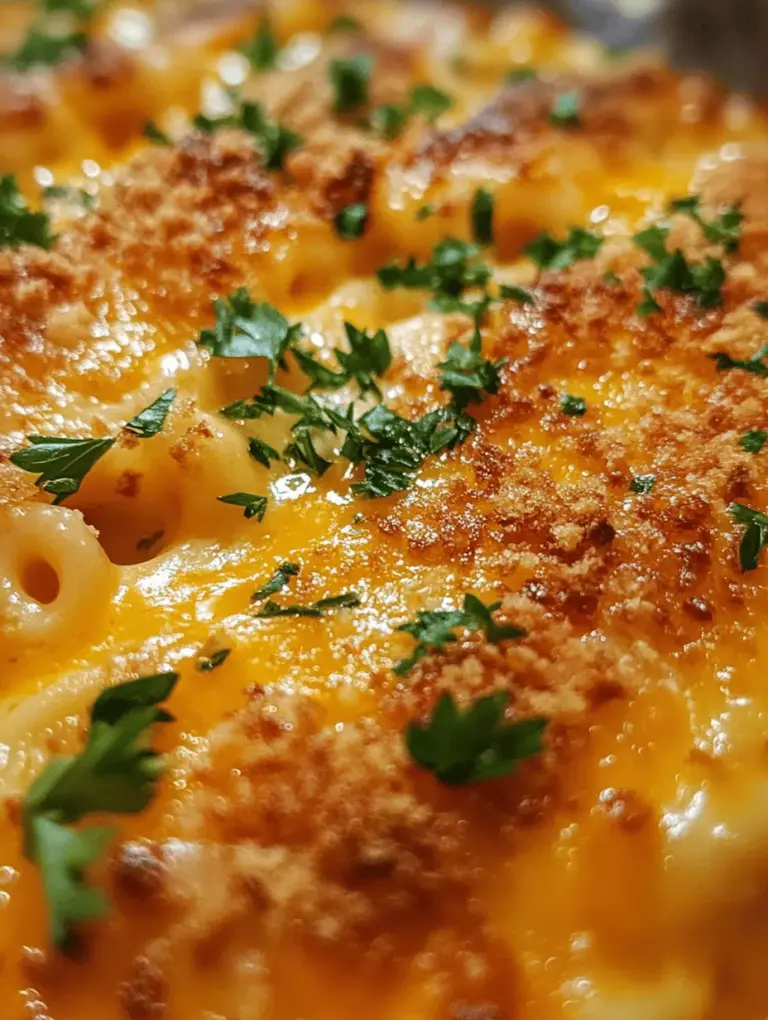Introduction
Macaroni and cheese, often affectionately dubbed “mac & cheese,” is a quintessential comfort food that has captured hearts and appetites across generations. This creamy, cheesy dish evokes memories of childhood, family dinners, and communal gatherings, making it a staple in many households. While store-bought options may offer convenience, nothing compares to the rich, satisfying experience of homemade mac & cheese, where you control the ingredients and flavors.
In this recipe, we elevate the traditional mac & cheese by combining a medley of cheeses and a hint of aromatic spices, creating a dish that is not only indulgent but also bursting with flavor. This Delightfully Cheesy Baked Mac & Cheese features a harmonious blend of sharp cheddar and nutty Gruyère, along with a crispy breadcrumb topping that adds an irresistible crunch. Let’s dive into what makes this recipe a must-try for cheese lovers everywhere.
The Allure of Baked Mac & Cheese
The history of mac & cheese traces back to the 18th century, with its roots steeped in European culinary traditions. The earliest known recipe for a cheese and pasta dish appeared in an Italian cookbook from the 1700s. Over the years, it has evolved into a beloved dish in various cultures, each adding their unique twist. In the United States, mac & cheese became a household favorite, particularly during the Great Depression for its affordability and comfort.
Globally, variations of mac & cheese exist, from the creamy versions found in the UK to the baked versions popular in Southern American cuisine. Each region brings its flavor, ingredients, and cooking techniques, showcasing the dish’s versatility and cultural significance.
Baked mac & cheese, specifically, elevates the dish to new heights. The baking process creates a delightful contrast between the creamy interior and a crispy, golden-brown top. This textural interplay not only enhances the overall eating experience but also allows the flavors to meld beautifully. The result is a comforting dish that is both visually appealing and deeply satisfying.
Ingredient Breakdown
Creating the perfect baked mac & cheese requires careful selection of ingredients. Here’s a closer look at the essential components that bring this dish to life.
Elbow Macaroni: The Ideal Pasta Shape
Elbow macaroni is the classic choice for mac & cheese, and for good reason. Its hollow shape allows for maximum cheese adherence, ensuring that each bite is packed with flavor. The small size of elbow macaroni also allows for even cooking and a pleasing texture, making it the perfect pasta for this dish.
Cheddar and Gruyère: Exploring Flavor Profiles
The cheese is undoubtedly the star of any mac & cheese recipe, and this version shines with a combination of sharp cheddar and Gruyère.
– Sharp Cheddar: This cheese brings a robust flavor that is key to the dish. Its tangy notes provide a perfect balance to the creaminess of the sauce. Sharp cheddar also melts beautifully, creating a luscious cheese sauce that clings to the pasta.
– Gruyère: Known for its nutty and slightly sweet flavor, Gruyère adds depth and complexity. This cheese is famed for its excellent melting properties, resulting in a creamy texture that enhances the overall dish.
Together, these cheeses create a rich and flavorful base that makes every bite an experience to savor.
The Role of Whole Milk in Achieving Creaminess
Whole milk plays a crucial role in achieving the creamy consistency that is characteristic of classic mac & cheese. The higher fat content of whole milk contributes to a luxurious mouthfeel, ensuring that the cheese sauce is rich and satisfying. Pairing whole milk with butter further enhances the creamy texture, making the sauce velvety and indulgent.
Seasonings and Their Contributions to Flavor
A well-seasoned mac & cheese is essential for a flavor-packed dish. In this recipe, we utilize a blend of spices that complement the cheeses beautifully:
– Garlic Powder: Adds a subtle, savory depth.
– Onion Powder: Enhances the overall flavor profile with a hint of sweetness.
– Mustard Powder: Introduces a slight tang that cuts through the richness of the cheese.
– Smoked Paprika: Offers a touch of smokiness that elevates the dish, giving it a unique twist.
– Optional Cayenne Pepper: For those who enjoy a hint of heat, cayenne pepper can be added to provide a gentle kick.
These seasonings work synergistically to elevate the flavor of the cheese sauce, making it more complex and satisfying.
The Importance of the Breadcrumb and Parmesan Topping
To achieve the perfect baked mac & cheese, a crispy topping is a must. A combination of breadcrumbs and grated Parmesan cheese creates a delightful crunch that contrasts with the creamy interior.
– Breadcrumbs: When baked, breadcrumbs form a golden crust that adds texture and visual appeal. You can use plain or seasoned breadcrumbs, depending on your flavor preference. Panko breadcrumbs are especially popular for their extra crunchiness.
– Parmesan Cheese: Adding Parmesan to the breadcrumb topping not only enhances the flavor but also contributes to the browning process during baking, resulting in a beautifully golden crust.
Step-by-Step Instructions
Now that we’ve explored the ingredients and their roles, let’s move on to the first step in creating this Delightfully Cheesy Baked Mac & Cheese: preheating the oven.
Preheating the Oven: Setting the Right Foundation
Before diving into the cooking process, it’s essential to preheat your oven. Set your oven to 350°F (175°C). Preheating ensures that your mac & cheese bakes evenly, allowing the cheese to melt perfectly and the topping to achieve that coveted golden crispness. While the oven is heating up, you can start preparing the other components of the dish, setting the stage for a deliciously cheesy experience.
With the oven preheated, you’ll be ready to assemble and bake your mac & cheese, ensuring a delightful dish that’s sure to please at any gathering or family dinner.
Stay tuned as we continue with the next steps in this recipe, guiding you through the process of crafting a truly memorable baked mac & cheese.

Cooking the Pasta
The foundation of any great baked mac and cheese starts with the pasta, and the choice of cooking method plays a crucial role in the final dish. Cooking your pasta to al dente—meaning “to the tooth” in Italian—ensures that it retains a slight firmness when bitten. This is vital because the pasta will continue to cook in the oven and absorb some of the cheese sauce. If you overcook the pasta initially, you risk ending up with a mushy texture after baking, which detracts from the overall experience of the dish.
To achieve the perfect al dente, boil the pasta in salted water according to the package instructions, but reduce the cooking time by about one to two minutes. Once the pasta is cooked, drain it immediately and rinse it briefly under cold water to stop the cooking process. This step also helps prevent the pasta from sticking together before mixing it with the cheese sauce.
Creating the Cheese Sauce
Now that you have your pasta cooked to perfection, it’s time to create the star of the show: the cheese sauce. This rich, creamy sauce is what makes baked mac and cheese indulgent and satisfying.
The Roux
The first step in making the cheese sauce is creating a roux—a mixture of fat (typically butter) and flour cooked together. The purpose of the roux is to thicken the sauce and create a smooth texture. Start by melting 4 tablespoons of butter in a saucepan over medium heat. Once it’s melted, add an equal amount of all-purpose flour (4 tablespoons) and whisk continuously for about 1-2 minutes. This allows the flour to cook and removes any raw taste. The roux should be a light golden color, which is essential for the flavor profile of your cheese sauce.
Gradually Incorporating Milk
After your roux is ready, it’s time to add the milk. Use about 4 cups of whole milk for a rich and creamy sauce. Slowly pour the milk into the roux while whisking vigorously to avoid lumps. Begin with a small amount, allowing the roux to absorb the liquid before adding more. This gradual incorporation is key to achieving a smooth sauce. Once all the milk is added, continue whisking over medium heat until the sauce thickens, which should take about 5-7 minutes. You’ll know it’s ready when it coats the back of a spoon.
Achieving the Perfect Balance of Seasonings
To elevate your cheese sauce and enhance its flavor, season it appropriately. Start with salt and freshly ground black pepper to taste. You can also add a pinch of cayenne pepper or paprika for a subtle kick. For added depth, consider incorporating a teaspoon of mustard or Worcestershire sauce. These ingredients will bring out the cheese flavors and provide a well-rounded taste to the dish.
Once your sauce is seasoned, begin adding the cheese. A combination of cheeses like sharp cheddar, mozzarella, and Gruyère works wonderfully to create a balanced flavor and texture. Stir the cheese into the sauce until it’s completely melted and smooth.
Combining Pasta and Sauce
With your cheese sauce ready, it’s time to mix it with the pasta. Transfer the drained pasta into a large mixing bowl or directly into the saucepan with the cheese sauce. Use a spatula or wooden spoon to gently fold the pasta into the sauce, ensuring every piece is evenly coated. This is where the magic happens—every bite will be a cheesy delight if done correctly!
Preparing for Baking
Before baking, it’s essential to transfer your mac and cheese into the right dish. A 3-quart baking dish is ideal for this recipe. If you want to ensure easy serving and cleanup, consider greasing the dish with butter or non-stick spray. This prevents the mac and cheese from sticking and creates a beautiful golden crust. Once the mixture is in the baking dish, you can smooth the top with your spatula for an even bake.
Breadcrumb Topping
To enhance the texture and flavor of your baked mac and cheese, a breadcrumb topping is a must. Combine 1 cup of breadcrumbs (panko works particularly well for added crunch) with 2 tablespoons of melted butter in a bowl. You can also mix in grated Parmesan cheese and a sprinkle of garlic powder or Italian herbs for extra flavor. Once combined, spread the breadcrumb mixture evenly over the top of the mac and cheese before baking. This topping will create a delightful contrast to the creamy pasta underneath.
Baking
Baking your mac and cheese is where the final transformation occurs. Preheat your oven to 350°F (175°C) and bake the dish uncovered for about 20-25 minutes. The goal is to achieve a bubbly, golden crust. Keep an eye on it towards the end of the baking time; if the top is browning too quickly, you can cover it loosely with aluminum foil. For an even crispier top, consider broiling the dish for an additional 2-3 minutes at the end, but watch it closely to prevent burning.
Serving Suggestions
Once your baked mac and cheese is out of the oven and resting for a few minutes, it’s time to serve! For the best taste experience, serve it warm, as the flavors are at their peak. Presentation can elevate your dish significantly—consider garnishing with fresh herbs like parsley or chives for a pop of color and freshness.
Pairing your baked mac and cheese with a light salad or steamed vegetables can create a well-rounded meal. A crisp green salad with a tangy vinaigrette can balance the richness of the mac and cheese. Alternatively, roasted vegetables like broccoli or Brussels sprouts provide a nutritious counterpoint.
For those looking to get creative, consider topping your mac and cheese with extras like crispy bacon, sautéed mushrooms, or even a drizzle of truffle oil. These additions can elevate your dish from comfort food to gourmet delight.
Nutritional Information
Understanding the nutritional content of your meal is important, especially when indulgence is involved. A serving of baked mac and cheese typically contains around 400-500 calories, depending on the ingredients used. Key nutritional factors include:
– Protein: Cheese and pasta provide a good source of protein, essential for muscle repair and growth.
– Carbohydrates: The pasta serves as a primary energy source.
– Fat: Cheese and butter contribute to the richness and creaminess of the dish.
For those with dietary restrictions, there are modifications you can make to enjoy this classic dish. Opt for gluten-free pasta to cater to gluten intolerances, and consider using vegan cheese options or plant-based milk for a dairy-free alternative. With these substitutions, you can still enjoy a deliciously cheesy baked mac and cheese that fits your dietary needs without sacrificing flavor.
Conclusion
Homemade baked mac and cheese is a delightful dish that brings comfort and joy to any table. The process of preparing it—from cooking the perfect pasta to creating a rich cheese sauce and adding a crunchy topping—creates a rewarding cooking experience. As you personalize the recipe to suit your tastes, whether through different cheeses, toppings, or sides, you’ll find that each variation holds its own unique charm.
Encourage yourself and others to try this recipe, embrace the creativity of cooking, and most importantly, share the joy of this beloved comfort food with loved ones. There’s something truly special about gathering around a warm dish of baked mac and cheese, reminiscing about family traditions, and creating new memories. So roll up your sleeves, preheat that oven, and enjoy every cheesy bite!

